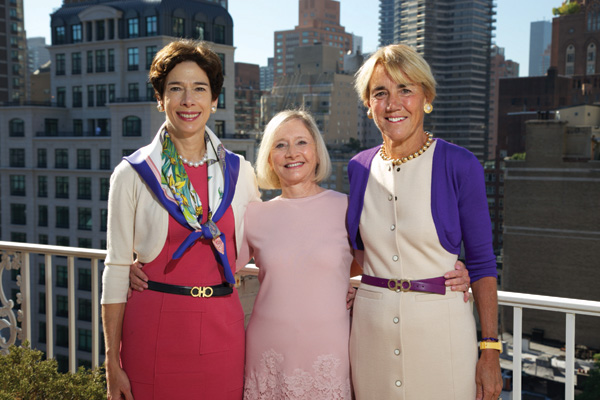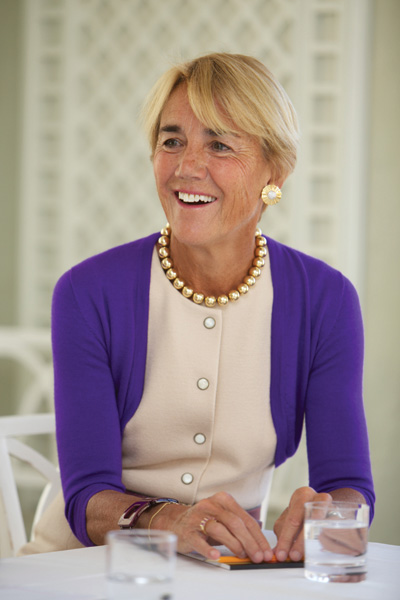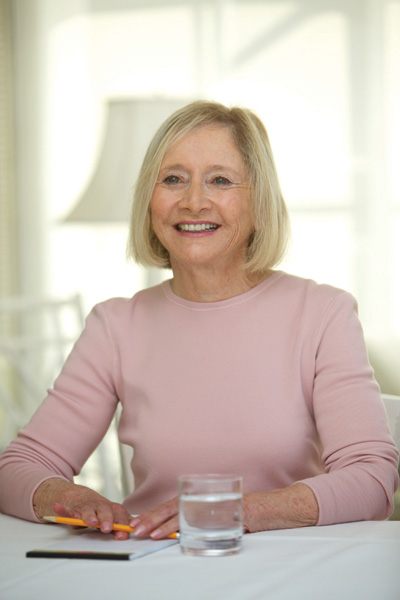Anatomy of a Triumph
How does a college exceed its $400 million fundraising goal in a tough economy? Just ask Vassar 150: World Changing campaign chair Barbara Manfrey Vogelstein ’76 and vice chairs Pat Parton Rosenwald ’56 and Missie Rennie Taylor ’68.

By now you may have seen the print ad or the We Did It video announcing the great success of the Vassar 150: World Changing campaign, which raised more than $431 million (far exceeding the stated goal of $400 million), the largest fundraising effort in Vassar history. And you likely read the communication from Chairman of the Board of Trustees William Plapinger ’74 and Campaign Chair Barbara Manfrey Vogelstein ’76 substantively detailing the wide-ranging results of the campaign—from 77 new named scholarships, to ongoing construction of the new Integrated Science Center, to five new endowed faculty chairs, to funds for the library, technology, and much more.
But how does the mammoth volunteer effort required to achieve such an ambitious goal come into being and thrive over eight years? To get an insider’s look at the campaign, the Vassar Quarterly sat down with Vogelstein and her two vice chairs, Pat Parton Rosenwald ’56 and Missie Rennie Taylor ’68.
The genesis of the volunteer effort began in fiscal 2005/06, the last year of Frances D. Fergusson’s 20-year presidency at Vassar. “There was this feeling that Fran had given the best years of her life to Vassar, and there should be something special we could do to honor her,” says Taylor. The result was a fundraising drive spearheaded by a group that informally came to be known as the “Fab Five”—Vogelstein, Rosenwald, and Taylor, plus Mary Pick Hines ’53 and Sally Lyman Rheinfrank ’63, both of whom would later serve on the campaign steering committee. That highly successful approach, conducted with frequent conference calls and marked by congeniality and conviviality, “just rolled into the campaign,” according to Vogelstein.

“We found we actually liked each other,” says Taylor, “and Barbara was the natural glue that held us together. She was the new generation” because, unlike the others in that group, she had gone to a coed Vassar. The college’s most recent campaign had been completed back in 1996.
Vogelstein says that once she agreed to chair the campaign, she knew that “Pat and Missie were the obvious vice chairs. They both had a lot of volunteer fundraising experience, and they knew everybody. And once the campaign got to a certain point, we decided on a conference call every week as a good way to keep everyone accountable.” Those Monday morning wake-up calls continued every week for several years.
“It just became part of your routine, after coffee,” says Taylor. “Sometimes I don’t think I even changed out of my bathrobe. Barbara ran them so well, you knew the meeting would be from 8:30 to 9:30, and you knew it would be over right at 9:30. There were always action items at the end, so it felt like you were constantly progressing. And the conference calls emboldened you, because you would hear what someone else had done, and you thought, ‘I can do that.’
“I did one call from Beijing, which was exactly 12 hours’ time difference, so that really wasn’t hard. But we all did California at one time or another. That’s when I learned there was a Starbucks in San Francisco that opens at 4:00 am.
“Our mantra was, ‘What are the one or two things that I can do today that can bring in the most money for Vassar?’” says Vogelstein. “It was all about structure and focus. A lot of what we were doing was figuring how to match the passions of alumnae and alumni with the needs of the school so we could get them really excited about the campaign.”

It might seem odd that the chair and vice chairs were all from New York City, until one stops to consider that some 27 percent of all Vassar alums reside in the New York metropolitan area, and an impressive 42 percent of the total campaign dollars (and almost half of all alumnae/i dollars to the campaign) came from there. Ultimately, the concentrated geography proved to be an advantage: “The whole world passes through New York,” says Rosenwald. Taylor cites another plus: “If there were people in New York who we felt were interested in donating, each of us could have different touch points with those people.”
With the officers established, a larger volunteer campaign leadership group was needed. “There was a system to creating the campaign committee,” says Vogelstein. “We had a matrix. We wanted it to be representative of all parts of the country, of different decades of graduates, the coed classes, and of course people with experience at fundraising. The original campaign steering committee of 25 expanded to a campaign committee of close to 40 after we went public. In the early days those meetings in person, on campus, were important.”
One of the campaign steering committee members was Virginia Cretella Mars ’51, who had chaired the Campaign for Vassar College that ended in 1996 with $206 million raised, a record for liberal arts colleges at that point. “Early on in the campaign,” Vogelstein recalls, “Ginnie said, ‘My generation has done its part. It’s time for the next generation to pick up the banner.’”
In fact, ultimately the Vassar 150: World Changing campaign encompassed both the all-women’s and the coed Vassar; the ’50s and the ’70s were the two largest contributors by decade to the final total. Still, says Taylor, “The campaign was a real statement about the coeducational Vassar experience. Jeffrey Goldstein [’77] was part of our conference calls ’til Obama called him away [the President appointed him Under Secretary of the Treasury for Domestic Finance]. We were very comfortably coed, having Bill Plapinger [who “turned out to be a formidable fundraiser,” says Vogelstein] as chair of the Board. We were surrounded by male grads who had an absolute passion for Vassar College.”
Adds Rosenwald, simply, “The men came through.”
It is customary for large fundraising campaigns to have a “silent phase” in which 50 to 60 percent of the target goal is raised before a general public announcement. The Vassar 150: World Changing “silent phase” was an unusually long one. While there were many contributing factors to that, one was overarching: the Great Recession and global financial crisis of 2007–2009.

Nevertheless, none of the three can recall a single comment by anyone that the campaign should be stopped while still in its silent phase. “We had to be sensitive to people’s situations,” Vogelstein says, “and come up with innovative structures for payments on the big gifts we were soliciting.”
“In a way it’s easier to raise money in a ‘quiet phase’ because you’re going to very large donors, and building a nucleus to grow from that point,” says Rosenwald. “You wanted to do that quietly.”
“I’d say it was quiet, but not a secret,” Taylor explains. “In casual conversations, people would ask, ‘What are you doing these days?’ and there was your opening.” With a long silent phase, she says, “You have this energy and get to a certain point, then you can get slack for a little while, and you need that next thing to push you on.”
Somehow, “that next thing” seemed to keep happening. “So many different people provided momentum by giving at just the right time,” says Vogelstein, “and we’re so grateful for that.”
That said, Vogelstein adds, “You have surprises on the upside and surprises on the downside.” Rosenwald recalls “one ask that left me very discouraged and very surprised by the donor’s negative answer. But then I can think of another big ask where the donor said yes so easily that Barbara and I felt like dancing afterward!”
Taylor reflects on another challenge: “We are on the campus a lot. We know the campus. One of the things we found we were dealing with was talking with people who hadn’t been there in a long time.” Rosenwald is only half joking when she says, “I was willing to rent a bus, wear the driver’s cap and everything, and drive all those people who hadn’t been back to campus to Vassar. The school is a completely different place than when they were there. It’s better than it ever was.”
Vassar 150: World Changing went public on January 18, 2011, 150 years after the New York State Legislature had chartered the college; the following month, the campaign’s first and largest public event took place at Jazz at Lincoln Center in New York. “The 150th played a big role,” says Taylor. “It helped provide opportunities to bring people together and to be refreshed about our history. Barbara was particularly eloquent in tying our history to our future.”
“We were thrilled that Meryl Streep [’71] emceed our public launch in New York,” says Vogelstein. “She is so dedicated that she flew back from filming The Iron Lady in London to be there. And we have to give [Sesquicentennial cochair and Senior Director of Regional Programs] John Mihaly [’74] enormous credit. That whole series of programs enabled us to have a platform all around the country and the world.”
“The Development Office was over the top,” adds Rosenwald, speaking of the entire campaign effort. “They were so great, there was not a thing they missed.”
“We can be extremely effective,” says Taylor, “but the Development team was triple-A-plus. The synergy was unique and powerful.” Vogelstein agrees with her vice chairs, noting that “the Development staff under [Vice President for Alumnae/i Affairs and Development] Cathy Baer’s leadership was superb.”
“The campaign was also structured to emphasize the importance of the Annual Fund,” Taylor notes. “That allowed for the engagement that was needed at all levels. People giving to the Annual Fund for the first time are our building blocks for the future.”
The group also cites the use of “challenges,” in which a donor or donors pledge a certain amount if others will collectively match what has been pledged. Most notably, an anonymous donor made a large pledge and challenged members of the classes of the 1970s to match it. “We were blown away by the donor’s concept,” says Taylor. “It gave us so much leverage.”
Vogelstein also is quick to emphasize “how terrific Cappy [President Catharine Hill] was. She was great at engaging donors, and people responded so well.”
“Cappy’s expertise is financial,” says Taylor, “and that was particularly important in bad economic times. She could explain the numbers to the steering committee and to donors, and that was reassuring to people.”
With more than $100 million raised in the final year alone, the campaign hit and then well exceeded its target. So what happens now? “We are discussing and developing plans,” say Vogelstein. “There are needs that remain. We could raise still more for the Integrated Science Center and for scholarships, and we’d like to get specific funding for the Vassar Veterans Posse Program and for career development. There are still people we didn’t get to ask.”
“Success breeds success,” adds Rosenwald, who is excited by the prospect of her grandson graduating from Vassar this spring. “There are people who might have been on the fence during this campaign who will look at what we’ve done and might be ready for the next campaign.”
In the meantime, what are they doing with their Monday mornings? “I exercise,” says Rosenwald with a laugh. “To quote my husband [who, like his wife, has run major campaigns and is 5’5” to his wife’s 5 feet in her highest heels], ‘Before this campaign started, I was 6 feet tall!’”
At the campus celebration of the successful completion of the campaign in October, Barbara Vogelstein, Pat Rosenwald, and Missie Taylor were honored with the creation of the Vassar 150: World Changing Scholarship as a tribute to their superlative leadership.
